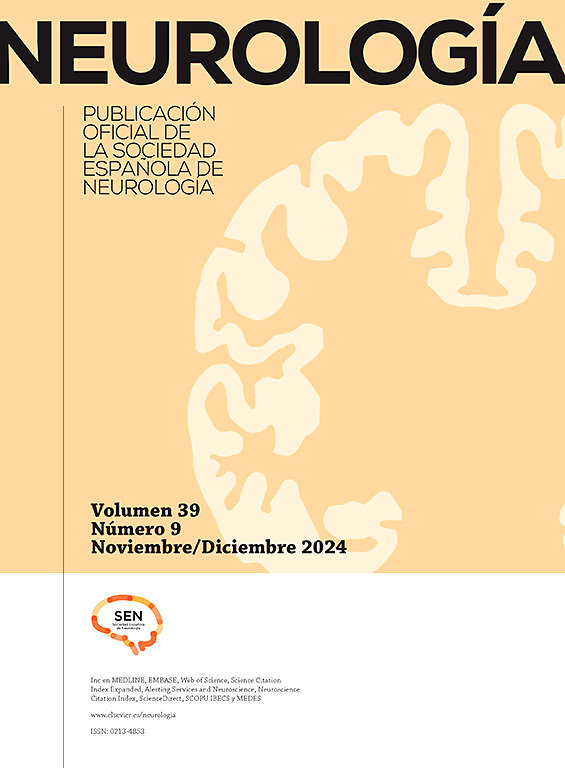La carga económica de la migraña: un enfoque nacional del coste de la enfermedad desde la Encuesta Europea de Salud en España en el año 2020
IF 3.1
4区 医学
Q2 CLINICAL NEUROLOGY
引用次数: 0
Abstract
Background
Migraine is a chronic highly disabling disease that manifests itself with recurrent episodes of headache. The objective of the study was to ascertain the cost-of-illness (COI) of migraine from the perspective of Society in Spain and to characterize its excess cost.
Methods
The nationwide year-2020 European-Health-Survey-in-Spain was used; 1,442 persons with migraine (77.3% women, 52.5 years) and 4,288 without migraine (76.7% women, 52.8 years) were abstracted by propensity score optimal matching. COI accounted healthcare resources utilization (HRU) and non-HRU (productivity loss). Costs were expressed as Per-Patient-Per-Year (PPPY) in Euros year 2020, and the excess cost was computed as the difference between persons with and without migraine.
Results
The PPPY cost was more than double in persons with migraine; €5,862 vs €2,981; excess cost of €2,881€ (95% CI: 2,410-3,353, p < 0.001), mainly attributable to labour productivity loss; €1,928 (1,532-2,325, p < 0.001) annually (66.9% of total excess cost). This excess labour cost is explained by the greater number of additional days of absenteeism, 22.35 (16.12; 28.57), and presenteeism, 31.39 (27.36; 35.41) in persons with migraine, p < 0.001 in both cases. National Health System (NHS)-funded healthcare PPPY cost represented the 29.0% of total excess cost; €836 (618-1,055), this because higher utilization of all-type medical visits.
Conclusion
In Spain, persons with migraine showed a meaningful excess cost compared with persons without migraine, particularly due to labour cost component, although the economic cost to the NHS was also considerable. Given the high prevalence of migraine, its overall attributable economic impact for Spain might range between 10,394 and 14,230 million Euros in year 2020.
偏头痛的经济负担:2020年西班牙欧洲健康调查以来对该疾病成本的国家方法
背景:偏头痛是一种慢性高度致残疾病,表现为反复发作的头痛。该研究的目的是从西班牙社会的角度确定偏头痛的疾病成本(COI),并表征其超额成本。方法采用西班牙全国2020年欧洲健康调查;通过倾向评分最优匹配抽取1442例偏头痛患者(77.3%女性,52.5岁)和4288例非偏头痛患者(76.7%女性,52.8岁)。COI计算了医疗保健资源利用率(HRU)和非HRU(生产力损失)。成本以2020年欧元的每位患者-每年(PPPY)表示,超额成本计算为偏头痛患者和非偏头痛患者之间的差异。结果偏头痛患者PPPY费用增加一倍以上;5862欧元vs 2981欧元;超额成本2,881欧元(95% CI: 2,410-3,353, p <;0.001),主要归因于劳动生产率的损失;1928欧元(1532 - 2325,p <;0.001)(占总超额成本的66.9%)。这一超额劳动力成本的原因是额外缺勤天数较多,为22.35天(16.12天;28.57),出勤率31.39 (27.36;35.41)偏头痛患者p <;两种情况下都是0.001。国家卫生系统(NHS)资助的医疗保健PPPY成本占总超额成本的29.0%;836欧元(618-1 055欧元),这是因为各类医疗访问的利用率更高。结论:在西班牙,偏头痛患者与非偏头痛患者相比,显示出有意义的超额成本,特别是由于劳动力成本的组成部分,尽管NHS的经济成本也相当可观。鉴于偏头痛的高患病率,到2020年,其对西班牙的总体经济影响可能在103.94亿至142.3亿欧元之间。
本文章由计算机程序翻译,如有差异,请以英文原文为准。
求助全文
约1分钟内获得全文
求助全文
来源期刊

Neurologia
医学-临床神经学
CiteScore
5.90
自引率
2.60%
发文量
135
审稿时长
48 days
期刊介绍:
Neurología es la revista oficial de la Sociedad Española de Neurología y publica, desde 1986 contribuciones científicas en el campo de la neurología clínica y experimental. Los contenidos de Neurología abarcan desde la neuroepidemiología, la clínica neurológica, la gestión y asistencia neurológica y la terapéutica, a la investigación básica en neurociencias aplicada a la neurología. Las áreas temáticas de la revistas incluyen la neurologia infantil, la neuropsicología, la neurorehabilitación y la neurogeriatría. Los artículos publicados en Neurología siguen un proceso de revisión por doble ciego a fin de que los trabajos sean seleccionados atendiendo a su calidad, originalidad e interés y así estén sometidos a un proceso de mejora. El formato de artículos incluye Editoriales, Originales, Revisiones y Cartas al Editor, Neurología es el vehículo de información científica de reconocida calidad en profesionales interesados en la neurología que utilizan el español, como demuestra su inclusión en los más prestigiosos y selectivos índices bibliográficos del mundo.
 求助内容:
求助内容: 应助结果提醒方式:
应助结果提醒方式:


